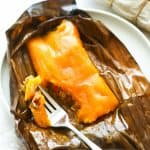Puerto Rican Pasteles
Tender, savory, and complex Puerto Rican delicacy. Delicious masa filled with a savory meat stew cooked and then steamed in banana leaves is an ideal treat for the holidays or any time. Their versatility is impressive.Makes about 10 pasteles
Servings 10
Calories 770kcal
Ingredients
Pork Filling
- 2 pounds pork, finely diced (from pork shoulder)
- 2-3 teaspoons minced garlic
- 2-3 tablespoons Puerto Rican sofrito
- 1 medium onion, finely diced
- 2 teaspoons oregano
- ½ cup red bell pepper, diced
- 1-2 tablespoons jalapenos pepper, diced
- 1 package Sazon sin achiote
- ½ cup tomatoes, chopped (or tomato sauce)
- 1 cup chickpeas (optional)
- salt and pepper to taste
Cassava Masa (Dough)
- 6 lbs cassava (yuca)
- 1½ tablespoons garlic powder
- 2 tablespoons onion powder
- 1 teaspoon salt
- 2 packet Sazon with achiote
- 4-5 tablespoons achiote oil
Traditional Masa
- 5-6 green bananas
- 1 green plantain
- 1 pound yautia, cocoyams, or taro root
- 1 medium potato
- 1 pound pumpkin (calabaza) or squash
Instructions
Masa (Dough)
- Cut both ends of the cassava (yuca) off and cut them in half.
- Make a shallow cut into the skin and gradually work your knife under it to remove the skin. Split it in half lengthwise, remove the woody core, and discard it.
- Cut into small chunks and rinse immediately to prevent discoloration, and leave them in cool water until ready to use.
- If making traditional masa, peel the bananas, plantains, taro root, potatoes, cocoyams, and pumpkin.
- Cut in small pieces and proceed with the rest of the instructions.
- Pulse the cassava (yuca) in a food processor until pureed, or grate it. You may have to do so in batches.
- Pour it out in a large bowl, then add the garlic powder, onion, salt, oil, and Sazon, thoroughly mix, and set aside.
Pork Filling
- Heat a large skillet over medium. As soon as it's hot, add 2-3 tablespoons of oil, add the diced pork, and cook until slightly brown or the pork is no longer pink (it may take 6-7 minutes).
- Add sofrito, garlic, onions, and oregano to the skillet, and cook for 3-5 minutes or until onions wilt.
- Throw in tomatoes and chickpeas, if using any. Then add about ¾ cup broth or water.
- Simmer uncovered until the liquid reduces and just coats the pork, about 15 minutes or more.
- Season the pork filling to taste with salt and let cool slightly. Adjust seasonings spices, if needed. Set aside.
Assembling Pasteles
- Prepare a work surface to assemble and wrap the pasteles. You may use a board or countertop for this process.
- If using freshly picked banana or plantain leaves, cut off the central rib and trim off the edges. Cut into the desired sizes. To make them flexible for folding, wilt them in single layers or slightly overlap them in a 200℉ (93℃) oven for 5-10 minutes. An alternative method of wilting is to place the leaves directly over the coils of an electric range on low heat or pass them carefully over the low flame of a gas range. Be careful not to burn them unduly. Wipe with a damp kitchen cloth or paper towel.
- To start the wrapping, place one parchment paper on a surface and top with one piece of banana leaf. Then brush with achiote oil.
- Add about two tablespoons of masa and spread it to form a small square, just like in the pictures.
- Add a spoonful of pork filling to the masa.
- Pick up the edge of the pasteles closest to you and fold it over the filling until the edge of the masa closest to you touches the other side. That helps the pasteles to stay fully enclosed. Fold the bottom edge of the square up and over so that the masa encloses the pork filling.
- Tie the pasteles with kitchen string. Repeat to form the remaining pasteles.
- At this point, you can freeze them for later. Place them in ziplock bags, date, label, and freeze.
Cooking Pasteles
- Line a large steamer or pot with a layer of banana leaf scraps.
- Add a cup or more of water – then bring to a boil. Next, place the pasteles in two loose layers. Add as much hot water as needed to almost submerge them. Cover with any remaining banana leaves.
- Let the pasteles cook for an hour or more, adding water as needed. Please don't let the pot dry out. Do a taste test if necessary to ensure the pasteles are fully cooked.
- Turn the heat off and let the pasteles cool in the pot for about 20 more minutes.
- Carefully remove pasteles with tongs, if they're still hot because you don't want to get burned.
- Transfer the pasteles to a platter. Remove the strings, carefully open pasteles – it releases hot steam as you open.
- Serve warm.
Notes
- Make this a family affair for easy assembly. If you're looking for a slow food experience, this is it.
- You can usually find frozen banana leaves in Latin markets. It does impart a unique taste to the already delicious pasteles.
- Please keep in mind that nutritional information is a rough estimate and can vary greatly based on the products used.
Nutrition
Serving: 1pastel | Calories: 770kcal | Carbohydrates: 113g | Protein: 21g | Fat: 26g | Saturated Fat: 8g | Polyunsaturated Fat: 4g | Monounsaturated Fat: 12g | Trans Fat: 0.02g | Cholesterol: 65mg | Sodium: 349mg | Potassium: 1134mg | Fiber: 7g | Sugar: 7g | Vitamin A: 374IU | Vitamin C: 71mg | Calcium: 82mg | Iron: 2mg
